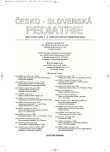Assessment of Clinical Signs of Intracranial Hypertension in Newborns and Infants with Hydrocephalus in Relationship to the Indication of Drainage Procedure
Authors:
B. Kolarovszki; J. De Riggo
Authors‘ workplace:
Neurochirurgické oddelenie JLF UK a MFN, Martin
primár MUDr. J. De Riggo, PhD.
Published in:
Čes-slov Pediat 2008; 63 (10): 521-527.
Category:
Original Papers
Overview
Assessment of clinical signs of intracranial hypertension in newborns and infants with hydrocephalus in relationship to the indication of drainage procedure.
Patients and methods:
The selected clinical signs were evaluated in the group of 24 newborns and 41 infants with hydrocephalus. The number of clinical examinations with the evaluation of intracranial dynamics was 165 (newborns 103, infants 62).
Results:
Clinical signs with the highes sensitivity in relationship to the indication of drainage procedure are: increased head circumference (72%), progressive growth of head circumference (61%), borderline tense anterior fontanelle (56%) and diastasis of cranial sutures (56%). Clinical signs with the highes specificity with adequate Younden’s index in relationship to the indication of drainage procedure are: unambiguous tense anterior fontanelle (99%), progressive growth of head circumference (98%), borderline tense anterior fontanelle (91%) and diastasis of lambdoid suture (88%).
Conclusion:
The results of our study showed the heterogenity of clinical signs of intracranial hypertension in newborns and infants with hydrocephalus in relationship to the indication of drainage procedure.
Key words:
newborn, hydrocephalus, intracranial hypertension, drainage procedure
Sources
1. Kolarovszki B, Šutovský J, Ďurdík P, et al. Etiológia a biomechanika detského hydrocefalu. Pediatria (Bratisl.) 2006;1(2): 84–87.
2. Kolarovszki B, De Riggo J, Ďurdík P, et al. Manažment novorodeneckého a detského hydrocefalu. Neurológia 2008;3(1): 41–44.
3. Barnes NP, Jones SJ, Hayward RD, et al. Ventriculoperitoneal shunt block: what are the best predictive clinical indicators? Arch. Dis. Child. 2002;87 : 198–201.
4. Štillová L, Strechová Z, Maťašová K, et al. Postnatal penicillin prophylaxis of early-onset group B streptococcal infection in term newborns: a preliminary study. Biomed. Pap. Med. Fac. Univ. Palacky Olomouc Czech Repub. 2007;151 : 79–83.
5. Kolarovszki B, De Riggo J, Ďurdík P, et al. Sledovanie intrakraniálnej dynamiky detského hydrocefalu. Pediatria (Bratisl.) 2006;1(3): 132–135.
6. Zibolen M, Zbojan J, Dluholucký S. Praktická neonatológia. 1. vyd. Martin: Neografia, 2001.
7. Katina S. Aplikácie MS v medicíne, vybrané kapitoly z analýzy kategorických dát, poznámky ku prednáškam. Texty ku prednáškam, LS 2006, 05. 04. 2006.
8. Eide PK, Due-Tønnessen B, Helseth E, et al. Differences in quantitative characteristics of intracranial pressure in hydrocephalic children treated surgically or conservately. Pediatr. Neurosurg. 2002;36 : 304–313.
9. Foyas IP, Casey ATH, Thompson D, et al. Use of intracranial pressure monitoring in the management of childhood hydrocephalus and shunt-related problems. Neurosurgery 1996;38 : 726–732.
10. Volpe JJ. Neurology of the Newborn. 4th ed. Philadelphia: WB Saunders, 2001.
11. Walsh P, Logan WJ. Continuous and intermitent measurement of intracranial pressure by Ladd monitor. J. Pediatr. 1983;102 : 439–442.
12. Easa D, Tran A, Bingham W. Noninvasive intracranial pressure measurement in the newborn. Am. J. Dis. Child. 1983;137 : 332–335.
13. Bass JK, Bass WT, Green GA, et al. Intracranial pressure changes during intermittent CSF drainage. Pediatr. Neurol. 2003;28 : 173–177.
14. Zibolen M, Čiljak M, Maťašová K, et al. Iatrogénna hypoproteinémia ELBW novorodenca ako faktor imitujúci atrofiu CNS. Pediatria 2008;3(S2): 71–72.
15. Leggate JRS, Baxter P, Minns RA, et al. Role of a separeted subcutaneous cerebro-spinal fluid reservoir in the management of hydrocephalus. Br. J. Neurosurg. 1988;2 : 327–337.
16. Gilkes CE, Steers AJW, Minns RA. Pressure compensation in shunt-dependent hydrocephalus with CSF shunt malfunction. Childs Nerv. Syst. 2001;17 : 52–57.
17. Katz DM, Trobe JD, Muraszko KM, et al. Shunt failure without ventriculomegaly proclaimed by ophtalmic findings. J. Neurosurg. 1994;81 : 721–725.
18. Kölfen W, Korinthenberg R, Schmidt H. Bedrohliche Hirndruckkrisen bei draniertem Hydrocephalus mit minimal erweiterten oder normalen Ventrikeln. Monatsschr. Kinderheilkund. 1989;137 : 297–301.
19. Lee TT, Uribe J, Ragheb J, et al. Unique clinical presentation of pediatric shunt malfunction. Pediatr. Neurosurg. 1999;30 : 122–126.
20. Casey AT, Kimmings EJ, Kleinlugtebeld AD, et al. The long-term outlook for hydrocephalus in childhood. Pediatr. Neurosurg. 1997;27 : 63–70.
21. Renier D, Sainte-Rose C, Pierre-Kahn A, et al. Prenatal hydrocephalus: outcome and prognosis. Childs Nerv. Syst. 1988;4 : 213–222.
22. Watkins L, Hayward R, Andar U, et al. The diagnosis of blocked cerebrospinal fluid shunts: a prospective study of referral to a paediatric neurosurgical unit. Childs Nerv. Syst. 1994;10 : 87–90.
23. Kimmings E, Kleinugtebeld AD, Casey ATH, et al. Does the child with shunted hydrocephalus require long-term neurosurgical follow-up? Br. J. Neurosurg. 1996;10 : 77–81.
Labels
Neonatology Paediatrics General practitioner for children and adolescentsArticle was published in
Czech-Slovak Pediatrics

2008 Issue 10
Most read in this issue
- Henoch-Schönlein Purpura from the Standpoint of Preventive Corticoid Administration
- Assessment of Clinical Signs of Intracranial Hypertension in Newborns and Infants with Hydrocephalus in Relationship to the Indication of Drainage Procedure
- Heterotopy of Stomach Mucosa – Review of Literature and Our Experience
- Prader-Willi Syndrome in Newborns – Two Case Reports
